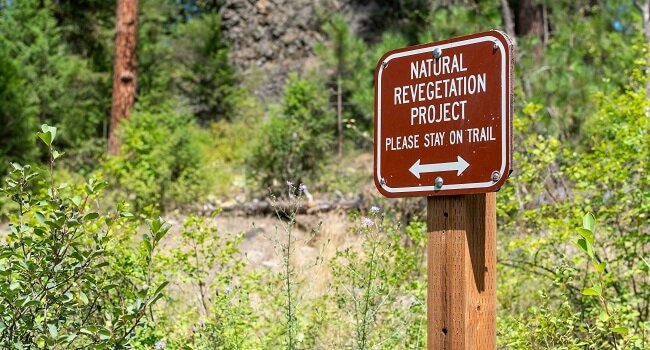Key Takeaways:
- Revegetation transforms barren, exposed soil left by construction into vibrant ecosystems, reducing erosion and enhancing biodiversity.
- Effective construction site revegetation relies on comprehensive planning, appropriate plant selection, and advanced soil preparation techniques.
- Regular maintenance, water management, and the use of innovative technologies ensure the long-term success and sustainability of revegetation projects.
Construction is a force of progress, shaping cities and infrastructure. But the progress often comes at a cost – barren landscapes of exposed soil. These dusty patches are not only unsightly, but also vulnerable to soil erosion, harming waterways and diminishing biodiversity.
That said, this guide offers a solution beyond the bulldozer’s reach: revegetation. It will explore the art of bringing life back to these disturbed areas, transforming them from ecological wastelands into flourishing ecosystems.
What Is Construction Site Revegetation?
Construction site revegetation therefore refers to a process of replanting vegetation on areas that might have been cleared or affected by constructions. This practice aims at restoring the natural environment and beautifying it to avoid further impacts such as soil erosion and other negative effects in relation to the soil quality. An effective technique employed in this process is coating the seeds with some type of layer to enhance germination ability and general viability. Thus, seed coating plays an important role in effective implementation of revegetation programs and guaranteeing the further successful development of the ecosystem.
Best Practices In Construction Site Revegetation
Implementing the following practices in construction site revegetation ensures successful and sustainable outcomes.
1. Comprehensive Planning and Site Assessment
A successful revegetation plan begins with comprehensive planning and site assessment. This involves conducting a thorough analysis of the site’s current conditions, including soil quality, climate, topography, and existing vegetation. Soil testing is crucial to determine nutrient levels, pH, and any contaminants present. Clear objectives should be set for the revegetation project, whether it’s to stabilize the soil, restore habitats, or enhance the aesthetic value of the area. Defining these goals early ensures that all efforts are aligned and measurable.
2. Selecting Appropriate Vegetation
Selection of appropriate vegetation is one of the most important steps that determine the success or failure of any revegetation process. The native species should be used because it adapts well to local conditions, is less demanding and promotes local wildlife. Also, choosing a combination of ground covers, shrubs, trees, grasses and wildflowers would help support a balanced ecosystem resisting pests and any environmental change. Moreover, this diversity also comes in handy in attaining various objectives that are related to projects like erosion control, habitat construction, and beautification of lands surrounding landscapes.
3. Soil Preparation
Soil preparation is a critical step that directly impacts the success of a revegetation plan. Soil testing should guide the amendment process, which may involve adding organic matter, correcting pH levels, and enhancing soil structure to promote healthy plant growth. Erosion control measures, such as installing silt fences, using erosion control blankets, and employing contour planting techniques, are essential to prevent soil loss and protect the newly planted vegetation. These measures ensure that the soil remains in place, providing a stable foundation for plant establishment.
4. Planting Techniques
Proper planting techniques are vital for the successful establishment of vegetation. The timing of planting activities should be carefully planned based on seasonal and weather conditions to maximize plant survival and growth. Depending on the plant types, different methods such as direct seeding, hydroseeding, or transplanting nursery-grown plants can be used. Each method has its advantages and should be selected based on the specific requirements of the site and the vegetation.
5. Water Management
Efficient water management is essential for the survival of newly planted vegetation. Installing efficient irrigation systems, such as drip or sprinkler systems, helps provide adequate water while minimizing waste. Water conservation techniques, like mulching, help retain soil moisture, reduce evaporation, and suppress weeds. Additionally, choosing drought-resistant plants can reduce the reliance on irrigation and ensure the sustainability of the revegetation plan.
6. Maintenance and Monitoring
Regular maintenance and monitoring are essential to ensure the long-term success of the revegetation project. Conducting regular site inspections helps identify issues such as pest infestations, plant diseases, or erosion problems early. Integrated Pest Management (IPM) strategies, which combine biological, cultural, mechanical, and chemical methods, can effectively control pests while minimizing environmental impact. Regular maintenance activities, such as weeding, mulching, and fertilization, are necessary to support plant growth and health.
7. Restoration Techniques
Employing effective restoration techniques can enhance the success of revegetation efforts. Contour planting involves planting along the natural contours of the land, which helps reduce runoff and increase water infiltration. This technique is particularly useful on slopes and can significantly reduce erosion. Terracing, which involves creating flat areas on steep slopes, can also improve water management and provide stable planting sites. These techniques help create a more sustainable and resilient landscape.
8. Encouraging Biodiversity
Promoting biodiversity is a key component of successful revegetation. Including pollinator-friendly plants can attract bees, butterflies, and other beneficial insects, supporting a healthy ecosystem. Creating wildlife habitats, such as birdhouses, bat boxes, and ponds, can further enhance biodiversity and provide refuge for various species. Biodiversity not only contributes to ecosystem stability but also enhances the site’s aesthetic and ecological value.
9. Utilizing Technology
Advancements in technology can significantly improve the efficiency and effectiveness of revegetation projects. Remote sensing technologies, including drones, can be used to monitor site conditions and plant health from above, providing valuable data for making informed decisions. Geographic Information Systems (GIS) mapping can help plan and manage revegetation projects by visualizing spatial data and tracking progress. These technologies enable more precise and efficient management of revegetation efforts, ultimately leading to better outcomes.
Conclusion

By following the best practices outlined in this guide, you’ll be well on your way to transforming a once-barren construction site into a thriving ecosystem. Remember, revegetation isn’t just about aesthetics; it’s about restoring balance to the environment, preventing erosion, and promoting biodiversity. Turn those scars into success stories, one flourishing revegetation project at a time.





























